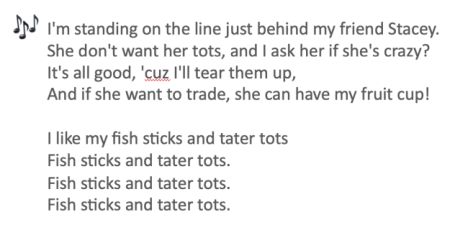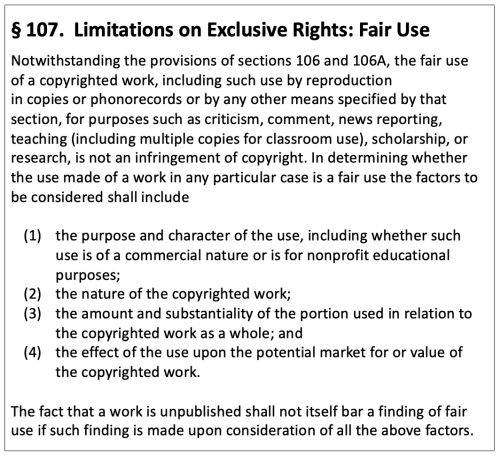Fish Sticks n' Tater Tots. A typical school lunch during Lent in a Catholic grammar school. Also the title of a children's song written by the plaintiffs that, in the words of the court, narrates "a student's journey from her classroom to her school cafeteria to eat fish sticks and tater tots for lunch." I hadn't heard the song before, but when I did, I was gobsmacked by its catchy cleverness. And let's just say that the court's understated description doesn't come close to giving the song the props it deserves. My favorite lyrics:

Check out the music video for yourself. I want to be friends with the plaintiffs. (I'm dead serious. @Shayda Brown, please DM me!)
The defendants (Netflix, Amazon and Apple) are streaming services that have made our pandemic lockdown slightly more bearable. In 2017, the defendants released Burlesque: Heart of the Glitter Tribe, a film that probes the onstage personas of a group of burlesque dancers in Portland. (Oregon, of course. Hard to imagine that there is a thriving burlesque community in Portland, Maine.) One of the dancers in the film incorporates eight seconds of the plaintiffs' song in a number she calls a "reverse mermaid." This is the court's description of the scene (with citations omitted):
[A] dancer, who goes by the stage name Babs Jamboree, performs an act in a food-themed show centered on the concept of a "reverse mermaid," which, in her telling, is a creature with the head of a fish and the legs of a woman. During the performance, Jamboree steps behind a sign labeled "hot oil" and emerges, having removed her fish head and changed into brown leggings to appear as though she has been transformed into fish sticks. During the performance, eight seconds of the Song plays, consisting of the lyrics "fish sticks n' tater tots" sung by Brown a total of five times. The performance continues for approximately 20 more seconds with different songs in the background.
They had me at "reverse mermaid" (which, apparently, is a thing). I'm watching this tonight. (Again, I'm serious.)
From here, the story is familiar. The songwriters feel like they have been ripped off. They sue (interestingly, only the deep-pocket streaming platforms and not the presumably less-well-heeled filmmakers). The defendants move to dismiss under Rule 12(b)(6) and for judgment on the pleadings under Rule 12(c). The court sides with the defendants. Here's a rundown of how the court applied the statutory factors under Section 107.

Purpose and Character of the Use: The plaintiffs argued that the use could not be transformative because the filmmakers had not altered the words or lyrics of the song and because the song and the scene in the film share the same subject matter - literally, fish sticks. The court disagreed, finding that the filmmakers had used the unaltered song as "raw material" to create a work with "undoubtedly[] new aesthetics" (citing Blanch v. Koons). Whereas the song tells a light-hearted children's story about a young girl waxing poetic about her favorite cafeteria lunch, the film depicts "decidedly mature themes." Moreover, the film's portrayal of fish sticks as part of a "reverse mermaid" could hardly be viewed as a "substitute for its tale of a student on her way to lunch." The court also rejected the defendants' argument that discovery was needed on the question of whether the film is a documentary that serves an educational purpose, or whether its purpose is purely commercial. Citing Cariou v. Prince, the court held that even if the film "were purely commercial, as Plaintiffs allege, because the secondary use is of a transformative nature, the first factor still weighs in favor of Defendants."
The Nature of the Copyrighted Work. While not disputing the plaintiffs' characterization of their song as a highly creative work (which often will tip this factor in a plaintiff's favor), the court found that the second factor was "of limited usefulness" here due to the transformative way the song was used in the film. Thus, the court concluded that the second factor was "neutral."
The Amount and Substantiality of the Portion Used. This factor requires the court to evaluate from a quantitative and qualitative perspective how much of the plaintiffs' song was used. Quantitatively, the court found that the film includes eight out of the song's 190 seconds, or 4.21% of the song, which was precious little. The court rejected as without precedent the plaintiffs' (rather clever) argument that it was more accurate to calculate the amount used in the film as 12.63% since the portion used comes from the chorus, which is repeated three times in the song. Qualitatively, the court was willing to assume that the film had appropriated the "heart" of the song. However, the court agreed with the defendants that the use of that "heart" was justified since it was necessary to fulfill the transformative purpose of the use. Specifically, "the dance depicted in the Film requires the phrase 'fish sticks and tater tots' to communicate the "reverse mermaid" transformation." Thus, the third factor also favored the defendants.
Effect of the Use on the Potential Market. Finally, the court found that the fourth factor weighed "decisively" in the defendants' favor. As the plaintiffs themselves acknowledged, the song and film are directed to different audiences (children and adults, respectively). And it was, in the court's view, exceedingly unlikely that the film would usurp demand for the song since it was hard to fathom that parents would purchase copies of the film so their minor children could hear a short excerpt of the song, instead of just buying the song itself. The court was unpersuaded that two derivative markets - identified by the plaintiffs as "music for an individual to at least appear to dance to, and as background music in films" - were potentially impacted by the defendants' use. The court suggested that these potential markets were more hypothetical than likely and noted that the plaintiffs had failed to allege in their complaint harm to these derivative markets and had only raised the issue in their brief. "Because Defendants met their burden by showing that the Film's secondary use would not usurp that of the original, other similarly hypothetical uses would equally not deprive them of prospective audiences."
Brown v. Netflix, Inc., Case 1:19-cv-01507-ER (S.D.N.Y. May 27, 2020)
This alert provides general coverage of its subject area. We provide it with the understanding that Frankfurt Kurnit Klein & Selz is not engaged herein in rendering legal advice, and shall not be liable for any damages resulting from any error, inaccuracy, or omission. Our attorneys practice law only in jurisdictions in which they are properly authorized to do so. We do not seek to represent clients in other jurisdictions.
